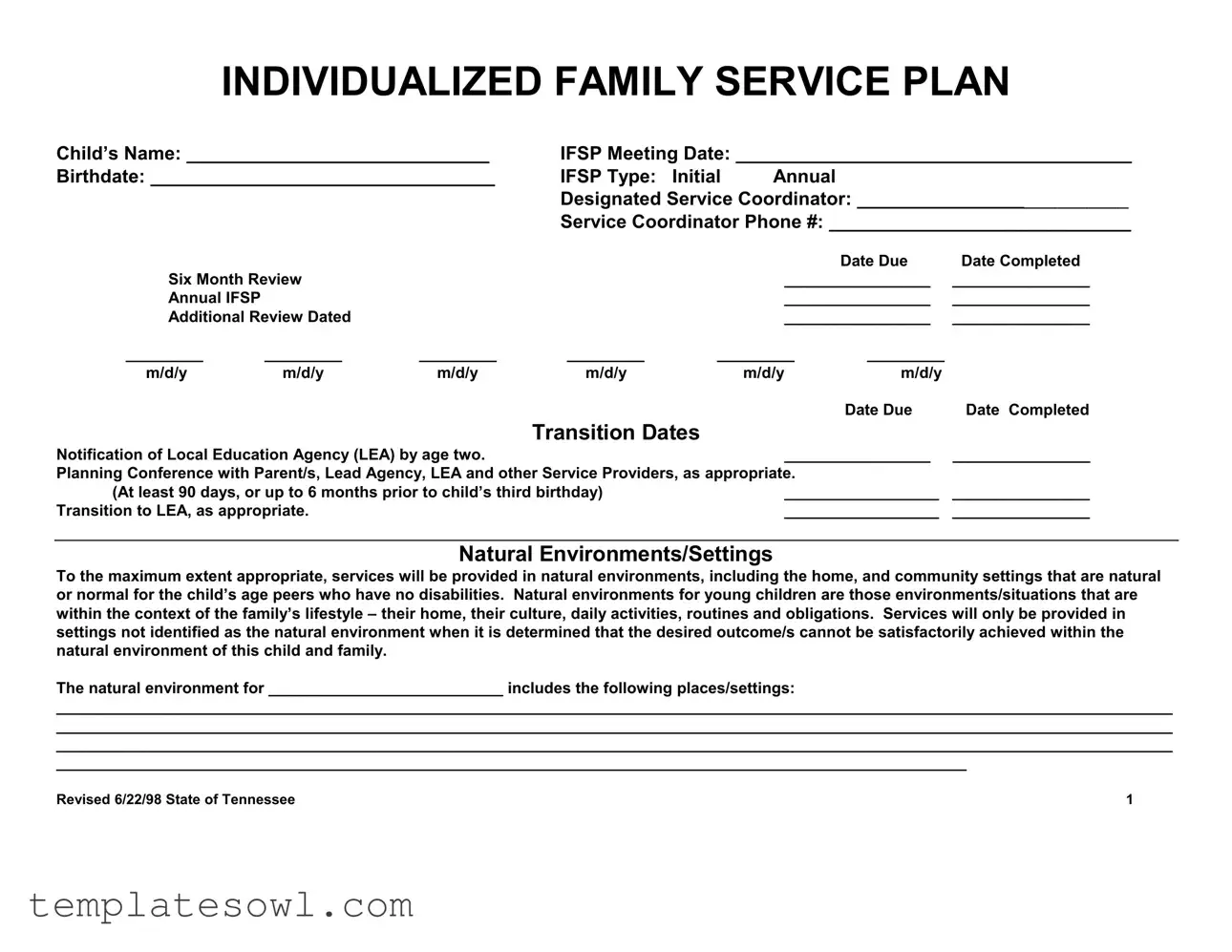
INDIVIDUALIZED FAMILY SERVICE PLAN
Child’s Name: _____________________________ |
IFSP Meeting Date: ______________________________________ |
Birthdate: _________________________________ |
IFSP Type: Initial |
Annual |
|
Designated Service Coordinator: __________________________ |
|
Service Coordinator Phone #: _____________________________ |
|
|
|
|
|
Date Due |
Date Completed |
Six Month Review |
|
|
_________________ |
________________ |
Annual IFSP |
|
|
|
_________________ |
________________ |
Additional Review Dated |
|
|
_________________ |
________________ |
_________ |
_________ |
_________ |
_________ |
_________ |
_________ |
|
m/d/y |
m/d/y |
m/d/y |
m/d/y |
m/d/y |
m/d/y |
|
|
|
|
|
|
Date Due |
Date Completed |
|
|
|
Transition Dates |
|
|
|
Notification of Local Education Agency (LEA) by age two. |
|
_________________ |
________________ |
Planning Conference with Parent/s, Lead Agency, LEA and other Service Providers, as appropriate. |
|
|
(At least 90 days, or up to 6 months prior to child’s third birthday) |
__________________ |
________________ |
Transition to LEA, as appropriate. |
|
|
__________________ |
________________ |
Natural Environments/Settings
To the maximum extent appropriate, services will be provided in natural environments, including the home, and community settings that are natural or normal for the child’s age peers who have no disabilities. Natural environments for young children are those environments/situations that are within the context of the family’s lifestyle – their home, their culture, daily activities, routines and obligations. Services will only be provided in settings not identified as the natural environment when it is determined that the desired outcome/s cannot be satisfactorily achieved within the natural environment of this child and family.
The natural environment for ___________________________ includes the following places/settings:
__________________________________________________________________________________________________________________________________
__________________________________________________________________________________________________________________________________
__________________________________________________________________________________________________________________________________
__________________________________________________________________________________________________________
Revised 6/22/98 State of Tennessee |
1 |
Page One: COVER PAGE |
|
Enter |
|
Child’s Name (first, middle, last) |
IFSP Meeting Date – date of this meeting |
Child’s Birthdate |
IFSP Type – check if Initial or Annual |
|
Designated Service Coordinator – name and agency |
|
Service Coordinator’s Phone # |
----------------------------------------------------------------------------------------------------------------------------------------------------------------------------
Planned Six Month Review date and Annual IFSP date – enter the approximate Date Due and, later, enter the Date Completed (actual date the meeting was completed.)
Additional Review Dates – enter the actual date(s) of occurrence(s).
----------------------------------------------------------------------------------------------------------------------------------------------------------------------------
Transition Dates
Notification of Local Education Agency, Planning Conference, and Transition to LEA – enter the approximate due dates and, later, the actual dates completed.
----------------------------------------------------------------------------------------------------------------------------------------------------------------------------
Natural Environment/Settings
Enter the name of the child, and list or describe places and settings the team, including the family, has identified as natural environments for the child.
Page Two: IDENTIFYING INFORMATION
Enter Child’s Name, Birthdate, Social Security Number, Address, Phone Number. Enter Parent’s Name(s) – the natural or adoptive parent and Parent’s Address, if different from child’s.
Eligibility
Enter a check next to the Part C eligibility which indicates the Part C eligibility criteria the child meets (check only one.) If eligible for DMR and/or CSS, check the appropriate box.
Referral
Enter the date of referral and state the specific agency, professional, or person making the referral.
Documentation (To be completed at the end of the meeting)
All members of the IFSP team should
1.Sign (if team member contributed but was not present, see #4.)
2.Enter the agency/title of the team member.
3.Enter date – the date of the meeting.
4.If team member contributed/not present at the IFSP meeting, print the name in the signature column and describe the method of contribution (conference call, written input, telephone call, etc.)
5.If team member fully agrees with the IFSP, check under “Fully Agree.” If team member disagrees with part of the IFSP, use the space indicated to document area(s) of concern. Attach additional pages if necessary.
Designated Service Coordinator/Agency and Rationale
Enter the name of the person/agency the team selected and the rationale the team used in selecting this person.
Informed Parental Consent
Parent check the appropriate boxes (each must be checked yes.) Parent(s) signature indicates that procedural safeguards have been followed.
Revised 6/22/98 State of Tennessee
IDENTIFYING INFORMATION
Child’s Name:
________________________________________________
Child’s Birthdate: ___________ Child’s Social Security #:
_____________
Child’s Address:
______________________________________________
Street
City: _________________________ TN Zip:
______________________
Phone: ________________ County:
_____________________________
Parent’s Name(s): ____________________________________________
Parent’s Address (if different from child):
___________________________
Street
City: __________________________ TN Zip:
_____________________
Phone: _____________________________________________________
|
|
Part C/TEIS/TIPS |
|
|
|
DMR |
|
|
CSS |
|
|
From Tennessee’ |
|
|
|
|
|
|
|
|
|
|
|
Definition of Developmental Delay |
|
|
|
|
|
|
|
Meets: (check if applicable) |
|
|
|
|
|
|
|
|
Eligibility |
|
|
|
|
|
|
|
|
|
|
|
|
|
% of Delay |
|
¨ |
|
|
|
DMR ¨ |
|
|
CSS ¨ |
|
|
Diagnosed Condition |
¨ |
|
|
|
|
|
|
|
|
|
|
Informed |
Clinical Opinion |
¨ |
|
|
|
|
|
|
|
|
|
|
|
|
|
|
|
|
|
|
|
Referral |
|
|
|
|
|
|
|
|
|
|
|
|
|
m/d/y |
|
|
|
|
m/d/y |
|
|
m/d/y |
|
|
|
|
|
|
|
|
|
|
|
|
|
|
|
|
Source |
|
|
|
|
Source |
|
|
Source |
|
|
|
|
|
|
|
|
|
|
|
|
DOCUMENTATION |
|
|
|
|
|
|
|
|
|
|
IFSP Team Member – If present, sign |
Agency/Title |
Date |
Contributed/ |
Fully |
Area(s) of Concerns/ |
If not present, list member’s name |
|
|
not present/method |
Agree |
Comments |
(Service Coordinator |
|
|
|
|
|
who organized this IFSP meeting) |
|
|
|
|
|
(Parent) |
|
|
|
|
|
(Parent) |
|
|
|
|
|
(Evaluator/Assessor) |
|
|
|
|
|
|
|
|
|
|
|
|
|
|
|
|
|
|
|
|
|
|
|
|
|
|
|
|
|
Designated Service Coordinator/Agency and Rationale
______________________________________________________________________________________________________________________________________________
|
|
|
_ |
|
Name |
Agency |
Address |
Phone # |
Rationale |
Informed Parental Consent
yes no
¨¨ I am the parent/legal guardian/Department of Education trained surrogate parent of this child.
¨¨ I have been informed of & understand my rights as a parent in Tennessee under Part C Regulations. I have received a copy of Rights of Infants and Toddlers with Disabilities.
¨¨ I have participated in the development of the IFSP and understand its contents.
¨¨ I agree to its implementation to the degree noted above.
____________________________________________________________________________________________________________
Revised 6/22/98 State of Tennessee 2
Pages Three and Four: PRESENT LEVELS OF DEVELOPMENT
Record, next to the word “By,” the name of the professional(s) who conducted the formal or informal screening, evaluation, or assessment which provided the information for the present levels of development. Enter the Date of the procedure and the child’s Chronological Age at the time of the procedure. If the child was at least four weeks premature and under the age of two, enter the Adjusted Age. A narrative statement must be provided which records the strengths and needs of the child in each area of development. Test results should be reported in quantitative form (age level, percentiles, etc.). If the adjusted age is less than zero, the quantitative form of test results is not required.
Record the strengths and needs of the child in the developmental areas, based on professionally acceptable, objective criteria. This information, along with the family’s resources, priorities, and concerns, will be used in determining the major outcomes. The “Other” space may be used for any additional information, including the family’s assessment of the child’s present levels of functioning (especially if the family has chosen not to have a Summary of the Family Resources, Priorities, and Concerns discussed at the IFSP meeting.)
Revised 6/22/98 State of Tennessee
PRESENT LEVELS OF DEVELOPMENT |
Child’s Name |
___________________________
(Include a statement of functional strengths & needs in each area)
Health |
By |
|
|
Date |
Chron. Age |
(Adj. Age) |
|
|
Strengths |
I |
Needs |
|
|
I |
|
|
|
I |
|
|
|
I |
|
|
|
I |
|
|
|
I |
|
|
|
I |
|
Vision |
By |
|
|
Date |
Chron. Age |
(Adj. Age) |
|
|
Strengths |
I |
Needs |
|
|
I |
|
|
|
I |
|
|
|
I |
|
|
|
I |
|
|
|
I |
|
|
|
I |
|
Hearing |
By |
|
|
Date |
Chron. Age |
(Adj. Age) |
|
|
Strengths |
|
Needs |
|
|
|
I |
|
|
I |
|
|
|
I |
|
|
|
I |
|
|
|
I |
|
|
|
I |
|
|
|
I |
|
Physical Development-Gross Motor By |
|
Instrument |
Date |
Chron. Age |
(Adj. Age) |
|
|
Strengths |
I |
Needs |
|
|
I |
|
|
|
I |
|
I
I
I
I
Physical development/Fine Motor |
By |
|
Instrument |
Date |
Chron. Age |
|
(Adj. Age) |
|
|
Strengths |
|
I |
Needs |
I
I
I
I
I
I
Revised 6/22/98 State of Tennessee 3
Child’s Name ________________________
PRESENT LEVELS OF DEVELOPMENT (Continued)
(Include a statement of functional strengths & needs in each area)
Communication Development (Speech/Language) |
By |
Instrument |
Date |
Chron. Age |
(Adj. Age) |
|
|
|
Strengths |
|
I |
Needs |
|
|
|
I |
|
|
|
|
I |
|
|
|
|
I |
|
|
|
|
I |
|
|
|
|
I |
|
|
|
|
I |
|
Cognitive Development |
By |
|
Instrument |
Date |
Chron. Age |
(Adj. Age) |
|
|
|
Strengths |
|
I |
Needs |
|
|
|
I |
|
|
|
|
I |
|
|
|
|
I |
|
|
|
|
I |
|
|
|
|
I |
|
|
|
|
I |
|
Social/Emotional Development |
By |
|
Instrument |
Date |
Chron. Age |
(Adj. Age) |
|
|
|
Strengths |
|
I |
Needs |
|
|
|
I |
|
|
|
|
I |
|
|
|
|
I |
|
|
|
|
I |
|
|
|
|
I |
|
|
|
|
I |
|
Adaptive Development |
By |
|
Instrument |
Date |
Chron. Age |
(Adj. Age) |
|
|
|
Strengths |
|
I |
Needs |
|
|
|
I |
|
|
|
|
I |
|
|
|
|
I |
|
|
|
|
I |
|
|
|
|
I |
|
|
|
|
I |
|
Other |
|
By |
|
Instrument |
Date |
Chron. Age |
(Adj. Age) |
|
|
|
Strengths |
|
I |
Needs |
|
|
|
I |
|
|
|
|
I |
|
|
|
|
I |
|
I
I
I
Revised 6/22/98 State of Tennessee 4
Page Five: SUMMARY OF FAMILY RESOURCES, PRIORITIES, AND CONCERNS RELATED TO ENHANCING THE DEVELOPMENT OF THE CHILD
Information given in this summary is to reflect the Resources, Priorities, and Concerns of the family as identified by the family. The assessment is voluntary on the part of the family. The assessment should come from multiple sources which could include focused interviews, informal interviews, surveys.
Indicate, by checking wither “yes” or “no” in the statements at the top of the page, the family’s decision concerning participation in a voluntary family-directed assessment and the inclusion of the voluntary family-directed assessment information in the IFSP.
Enter the type(s)/method(s) of family assessment used, the date(s) that the family assessment(s) took place and the names of all who paricipated in the assessment process, including family members and professionals.
Enter in narrative or list form, a summary of
1.Family Resources that are available to the family, including formal and informal supports systems, educational resources, personal resources of family members (for example, the mother does not work outside the home and is very motivated to take her child and has time readily available to take her child to needed appointments, or the family is aware of their financial situation and is willing to accept financial help if it can secured.)
2.Priorities of the family—those things which are most important for the child and family.
3.Concerns of the family, including concerns the family has regarding their ability to cope with the child’s situation (for example, the family has a low income and is very concerned about its ability to pay for services their child needs.)
Revised 6/2/98 State of Tennessee
Child’s Name ____________________________
SUMMARY OF FAMILY RESOURCES, PRIORITIES, AND CONCERNS RELATED TO ENHANCING THE DEVELOPMENT OF THE CHILD yes no
¨¨ Family agreed to a voluntary family-directed assessment.
¨¨ Family agreed to the inclusion of the voluntary family-directed assessment in the IFSP.
Type(s)/method(s) of Family Assessment Used: _________________________________________________________________________________________________
Date(s) of Family Assessment:
_______________________________________________________________________________________________________________
Participants
______________________________________________________________________________________________________________________________








